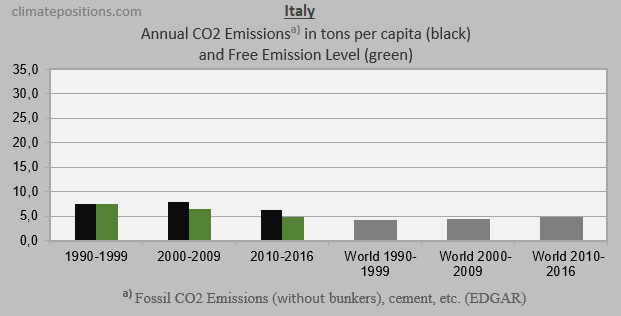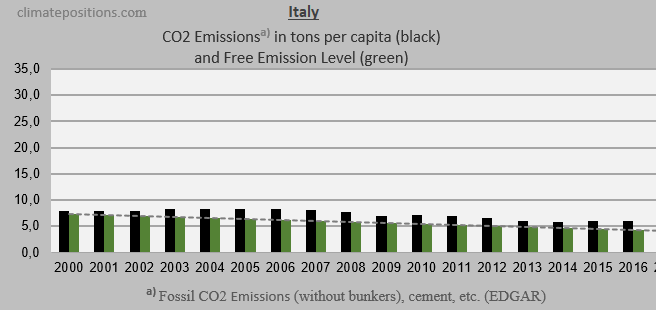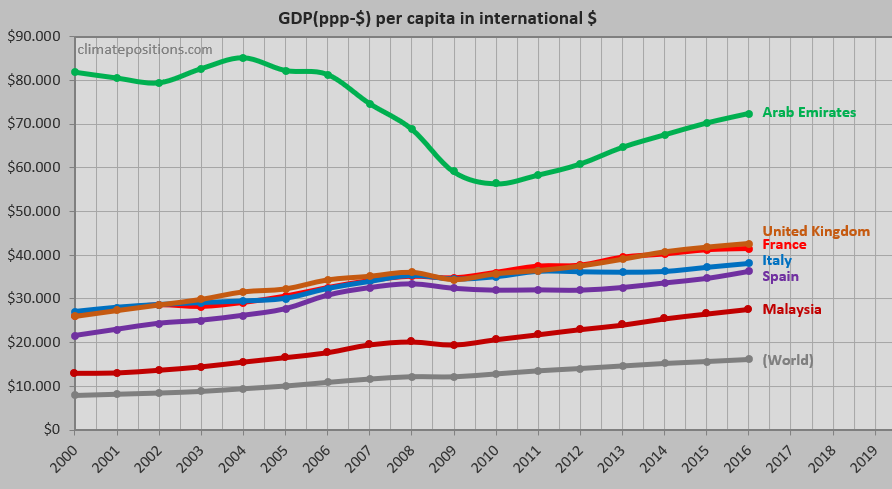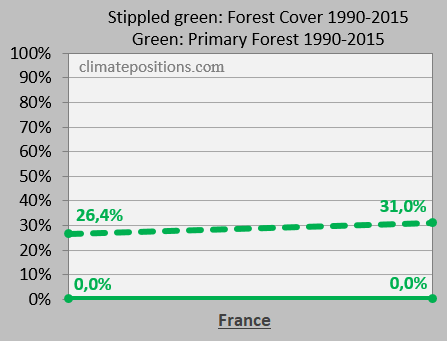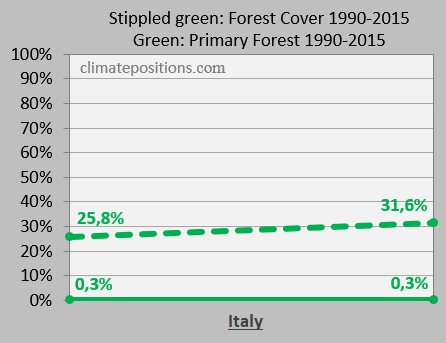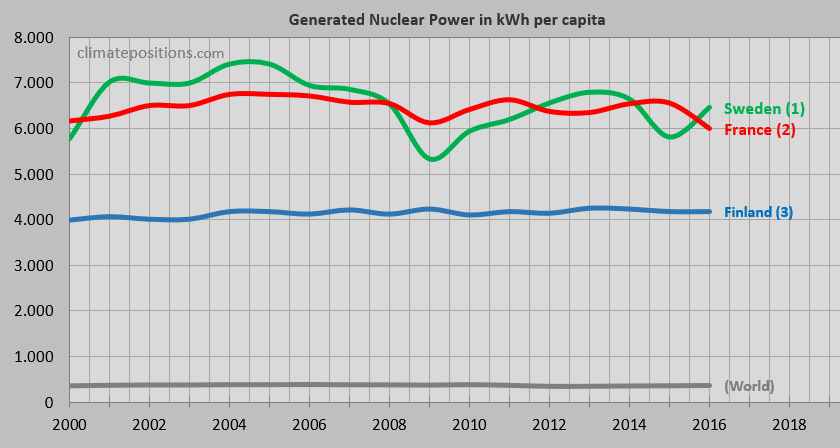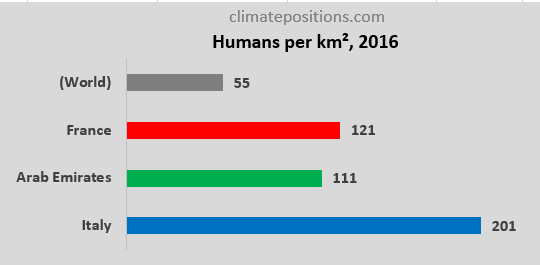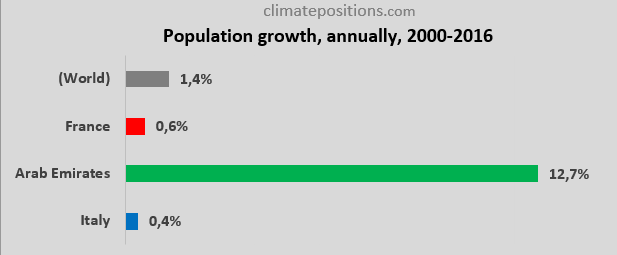Share of global Climate Debt rank 13th, 14th and 15th: France, United Arab Emirates and Italy (combined responsible for 3.5% of Climate Debt and 2.5% of Fossil CO2 Emissions 2016)

2017
The diagram below shows ‘Share of global Climate Debt‘ in 2010, 2015 and 2017 of France, United Arab Emirates and Italy (ranked 13th, 14th and 15th). The share of United Arab Emirates has increased along with an extreme population growth.
The following exposes the key-data in the Climate Debt calculations: Fossil CO2 Emissions, GDP, Environmental Performance, Ecological Footprint without carbon, Forest Cover, Primary Forests, Nuclear Power, Population trends and climate change financing. For comparison, United Kingdom, Spain and Malaysia (ranked 16th, 17th, and 18th in Share of global Climate Debt) are included in some diagrams.
The ‘Per capita Climate Debt‘ accumulated since 2000 of France, United Arab Emirates and Italy are $1,374, $9,200 and $1,295, respectively. The second diagram shows the trends between 2010 and 2017, with world average set at 100, for the three countries as well as of United Kingdom, Spain and Malaysia. The per capita Climate Debt ranking by October 2017 is shown in brackets.
The next three diagrams show Fossil CO2 Emissions from fuels and industrial processes¹, in tons per capita in decades, of France, United Arab Emirates and Italy. The green bars show the Free Emission Level² – the exceedance is the basis for calculating the national Climate Debt. The grey bars are World emissions average.
CO2 Emissions data 1990-2016 (EDGAR) has been updated October 2017.
The three diagrams below show the per capita Fossil CO2 Emissions from fuels and industrial processes¹, annually since 2000, of the three countries. The green bars show the Free Emission Level². Since 2011, the Emirati per capita emissions have increased by 16%. The French and the Italian reduction-rates are inadequate.
The diagram below shows per capita GDP(ppp-$) of the six countries and the World average. The wealth of United Arab Emirates is 4.5 times greater than World average.
The next diagram shows the Relative Environmental Performance of France, United Arab Emirates and Italy, with an average country set at 100. The performance of the extremely wealthy Arab Emirates China is now nearby an average country in the World. [Added 25-1-2018: See the new ‘Environmental Performance Index 2018‘]
The average per capita Ecological Footprint without carbon, between 2000 and 2013, with an average World country set at 100, of France, United Arab Emirates and Italy are 164, 151 and 137, respectively. Release years are about four years after data years. The French Climate Debt would have been 7.1% smaller with World average footprint. Note that footprint calculation methods have changed over time. The latest and historic details from the source are available here: ‘France‘ and ‘Italy‘ (data of United Arab Emirates is missing at the site).
Forest Cover and the precious Primary Forests as percentage of total land area, in 1990 and 2015, are important indicators in ClimatePositions. France and Italy both increased the Forest Cover, while the precious Primary Forests of Italy is still negligible (the French Primary Forests is set at zero due to lack of data from the source). Arab Emirates increased Forest Cover from 2.9% of total land area in 1990 to 3.9% in 2015, while Primary Forests are still zero.
The per capita Nuclear Power generation 2000-2016 is shown below (the per capita ranking is shown in brackets). France, with the world’s 2nd largest per capita Nuclear Power generation, is shown along with Sweden and Finland ranked 1st and 3rd. In the calculation of Climate Debt, Nuclear Power must be phased out similar to Fossil Fuels, calculated as if Nuclear Power was oil-generated.
The diagrams below show Population density 2016 and growth between 2000 and 2016. United Arab Emirates has the World’s 2nd highest Population growth-rate (after Qatar). The Populations of France, United Arab Emirates and Italy are about 67, 9 and 61 million, respectively.
Finally, the table below shows four key values of France, United Arab Emirates, Italy, United Kingdom, Spain and Malaysia in the calculation of national Climate Debts in ClimatePositions. The price of CO2 per ton (column two) is for total CO2 Emission from Fossil Fuels (without bunkers) and industrial processes. Climate change financing (column three) is from July 2017.
| . | Tons of CO2 | Price per | Climate change | Financing as |
| . | exceeded since | ton CO2 | financing | share of |
| . | 2000, per capita | since 2000 | per capita | Climate Debt |
| . | . | . | . | . |
| France | 25.25 | $13.58 | $11.20 | 0.81% |
| Arab Emirates | 95.24 | $22.22 | $0.00 | 0.00% |
| Italy | 25.21 | $10.48 | $2.64 | 0.20% |
| United Kingdom | 19.84 | $8.05 | $40.86 | 3.87% |
| Spain | 30.46 | $12.45 | $5.60 | 0.39% |
| Malaysia | 60.54 | $17.00 | $0.00 | 0.00% |
.
¹Fossil CO2 Emissions include all anthropogenic emissions from Fossil Fuel (combustion and production) and from industrial processes (cement, steel, liming, urea and ammonia production or consumption). The uncertainty in Fossil CO2 emissions is below 5% for industrialized countries and below 15% for developing countries.CO2 Emissions from international shipping and aviation (bunkers) are not included.
²The Free Emission Level (green bars) is determined by national CO2 Emissions 1990-1999 (base), and 11 more ‘Indicators‘, of which 7 are national and 4 are global.
.
Updated data and diagrams of all ‘Indicators‘ and all countries in ClimatePositions are available in the menu ‘Calculations (Excel)‘.
Data on Fossil CO2 Emissions (excluding international shipping and aviation) and industrial processes (cement, steel, liming, etc.) are from EDGAR (European Commission) (links in the menu Calculations / Sources & Links).
Information on national GDP(ppp-$) per capita: Worldbank (links in the menu Calculations / Sources & Links).
Source on Environmental Performance: Yale and Columbia University (links in the menu Calculations / Sources & Links).
Source on Ecological Footprint: Global Footprint Network (links in the menu Calculations / Sources & Links).
Data on national Forest Cover and Primary Forests are from United Nations UN (Report: Global Forest Resources Assessments) (links in the menu Calculations / Sources & Links).
Data on national Nuclear Power generation: World Nuclear Association (links in the menu Calculations / Sources & Links).
Data on national and global Populations is from Worldbank (links in the menu Calculations / Sources & Links).
PowerPoint collage with flags by Claus Andersen, 2017.
Comments are closed.




